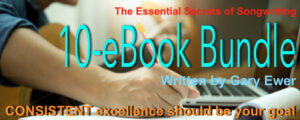Musical energy is the lifeblood of a song. When you talk about a song’s ability to grab the listener’s attention and then keep them listening for the three or four minutes that it lasts, that all comes down to musical energy.
So often people equate musical energy with volume (loudness) or tempo, but that’s not usually accurate. Even soft ballads need energy to keep people listening, and I would go further and say that ballads, more than loud and fast rockers, need to pay even closer attention to musical energy.
 The best songwriters are best because of the power of the words they use. Read “Use Your Words! Developing a Lyrics-First Songwriting Process” in order to become a better lyricist. Right now it’s a FREE add-on to “The Essential Secrets of Songwriting 10-eBook Bundle.”
The best songwriters are best because of the power of the words they use. Read “Use Your Words! Developing a Lyrics-First Songwriting Process” in order to become a better lyricist. Right now it’s a FREE add-on to “The Essential Secrets of Songwriting 10-eBook Bundle.”
It may seem contradictory to say that both loud rockers and soft ballads need musical energy, but it’s not contradictory if you consider a more accurate definition of what we mean by musical energy. To me, musical energy — at least in most music — comes down to what we might more accurately call emotional energy.
The best songs usually feature a noticeable up-and-down of its emotional content, and lyrics often play an important role. Yes, you can hear an up-and-down of the energy of a song’s basic components, like its instrumentation and general loudness (quieter in the verses, louder in the choruses), but take a close look at the words being sung, and you’ll see that the song’s emotional “map” is typically guided by the emotional content of the words.
That up-and-down, by the way, is an important aspect of what makes songs work. Songs that are full-on emotional all the time have the effect of wearing the audience down and dulling their musical interest.
But a song that starts low in emotional energy, builds toward the chorus, and then dissipates for the start of the next verse, has more staying power. People love the effect that fluctuating energy levels has on their emotional state, and they’re far more likely to keep coming back to a song that generates emotions and then lets them subside so that they can build up again.
In your own songwriting, an examination of musical energy should start by an examination of your lyric:
- Read through your lyric, and see if you’ve been able to create words and phrases that build emotions and then lets them subside.
- Create an instrumental approach for your song that builds alongside the lyric, and then becomes more transparent and quieter when the lyric becomes more observational and less emotional.
- The quieter a song is, the more subtle the effects of emotional building and subsiding should be.
- Use the range of the singer’s voice to its best effect. Higher notes create a more intense sound that enhances musical emotions and energy.
A great example of a song that uses lyrics, instrumentation, tempo and loudness in a close partnership to great effect is “Stairway to Heaven” (Jimmy Page, Robert Plant). In this case, though there is a subtle sense of up-and-down of musical energy, we hear the impressive effect of a long, gradual crescendo of effects from beginning to end.
 Written by Gary Ewer. Follow Gary on Twitter.
Written by Gary Ewer. Follow Gary on Twitter.
 “The Essential Secrets of Songwriting” eBook bundle includes “Writing a Song From a Chord Progression”. Learn how to write great songs by starting with the chords, and then avoiding all the potential pitfalls of the chords-first songwriting process.
“The Essential Secrets of Songwriting” eBook bundle includes “Writing a Song From a Chord Progression”. Learn how to write great songs by starting with the chords, and then avoiding all the potential pitfalls of the chords-first songwriting process.










